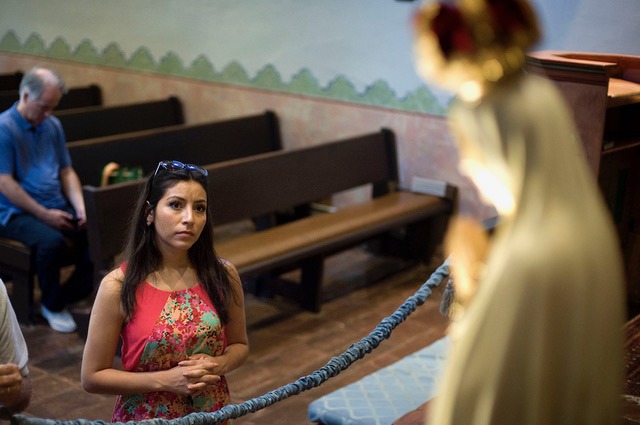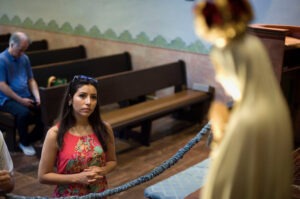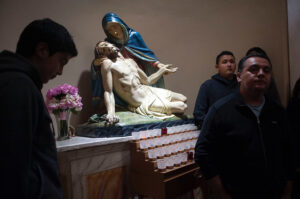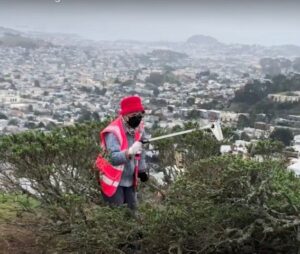The Catholic Church in the United States is split over the role of women, and whether Joe Biden should receive Holy Communion, but these divisions pale in comparison to the gap between the hierarchy and many young Catholics. They are dropping out in a quiet, steady stream, with grave implications for the future of the country’s largest religious denomination.
Irene, a twenty-nine-year old woman in San Francisco who was raised Catholic, no longer attends Sunday mass and ignores other obligations of the faith. As a child she went to church with her parents, and most of her friends were Catholic. Sometimes they played “procession,” sprinkling flowers on a garden path to an “altar” they had decorated, taking turns at first in line. At her Catholic high school, students planned a weekly liturgy by themselves. “I always looked forward to it,” she told me. At a Catholic university, she went to weekday evening masses at the campus chapel – “they were smaller than Sunday masses,” so participants “got to know each other.” Some Sundays, she walked to a parish attended by immigrant families of the children she tutored – “I felt I knew them.”

In recent years, as an adult out in the world, “Irene” – she prefers not to use her real name –said she feels the Church is less embracing than it once seemed. She still calls herself “Catholic,” and on the Ash Wednesday before the pandemic lockdown I saw her with the remains of a carbon-smudge on her forehead. She told me she had stopped by a local church, in a manner that suggested old habits die hard. But independence from home sparked questions about the faith. The Church’s answers do not satisfy her.
“Why aren’t my gay friends welcome?” (Answer: They are welcome, but they must accept their homosexuality is “intrinsically disordered.”) Two of Irene’s friends work for an organization that supports the rights of young girls, including pre-teens, who have been raped, and want abortions. She admires her friends’ work and agrees with it. But the Church says abortion, at any stage and under any circumstances, is “gravely contrary to the moral law,” and others must not facilitate the procedure.
“What’s that about?” Irene asks. “There’s not even any conversation allowed.”
According to a 2020 survey by the Public Religion Research Institute (PRRI), thirty-six percent of U.S. millennials – between ages 16 and 29 — identified themselves as “nones,” or religiously unaffiliated, up from just ten percent in 1986. Fifty per cent of Catholic millennials claim they have no religious identity. The Church is fighting for its young with parish Young Adult Ministries, campus outreach groups like long-standing Newman Centers (2000 nationwide) and the more recent Fellowship of Catholic University Students, (on 168 campuses) or with programs like Theology on Tap that draw participants for fellowship around a beer.
Of the millennials who stay, some have nuanced attitudes toward Church teachings. On the other side of the country from Irene, 27-year-old Andrea Waclawek of Buffalo, New York, attends mass regularly and insists that young practicing Catholics “are not a monolith.” The pro-life stand of the Church, she said, is “more than just about abortion.”
“I’m comprehensively pro-life, absolutely concerned about abortion, and equally concerned about affronts to human dignity, high rates of suicide, people suffering at the border,” said Waclawek, who is married and expecting her first child.“If we’re really pro-life we have to have to help to spread the understanding of the sanctity of human life at all points, not just [at the point of] the unborn fetus.”
In a telephone interview, Waclawek said she had enjoyed studying theology at university and now teaches the subject to Catholic high school-age students. However, “I could name on one hand those I’m confident will continue to practice – they believe in God but have hesitations about affiliating with a church that doesn’t feel progressive enough.”
Adults a generation older than Waclawek who left the Church have expressed anger to her at the sex abuse crisis, she said, or at the lack of substantive changes after the Second Vatican Council (Vatican II) of the 1960s, which was meant to modernize rites and give more roles to lay people. However, she said, “people my age, in their 20s and 30 who leave, “are not angry, and respect that I practice,” and there is “no single reason” for their departure. But many object to teachings on contraception and gay marriage. Some say religion conflicts with science. “They don’t try and talk me out of it, but have an attitude that says “’you do yours and I’ll do mine.’”

Kaya Oakes, a Catholic writer and lecturer, has studied the “nones.” In an interview, Oakes said “there’s no data to show that younger Catholics are staying in the Church.” Their generation “does not trust” authority figures as previous generations did. “And it’s worse now because they saw how bishops on the religious right supported the Trump government for four years – that’s not going to bring them back.”
The hierarchy knows why young adults walk away from the pews. After two years of investigation, bishops meeting in the 2018 Synod on Young People, Faith, and Vocational Discernment in Rome, listed reasons in a final document: sex scandals and economic scandals; homilies inadequate to the issues of young lives, parishes that do not engage them enough, clergy who do not listen enough.
Another reason may be that young Catholics don’t see women at their altars, not even as deacons, much less as priests. “The young also clamor for greater recognition and greater valuing of women in the society and in the Church,” the bishops concluded.
Brenda Noriega, 31, a layperson who works in Los Angeles for the Maryknoll order, is one of four young adults from various countries advising the Vatican’s Office of the Family and Laity. She supports the idea of women deacons – currently only men, single or married, can be ordained into the Catholic diaconate.
“I know the argument is that none of the apostles were women, but in the Scriptures we see women in charge of the small [early church] communities,” she said in a video interview. The first to be ordained should be the wives of present male deacons, because they are working alongside their husbands already, Noriega said, “attending to the communities.”
The gap is particularly great between young adults and Church teaching on what some Catholics call “the pelvic issues” – pre-marital sex, birth control, abortion, homosexuality. In the 1960s, when the pill became widely available, Pope Paul VI issued an encyclical confirming the Church’s prohibition of artificial birth control. Most Catholic couples ignored it. (Bishops advocate the “rhythm method,” which involves calculating a woman’s fertile period, and is considered one of the least effective means of birth control.) The rules remain, but teaching on family planning is rarely addressed from the pulpit. Abortion looms as a bigger, more divisive issue.
In its instructions to Catholics on “Faithful Citizenship” The United States Catholic Conference of Bishops (USCCB) lists preventing abortion as the “pre-eminent priority” when choosing political leaders, even though Pope Francis stresses that other pro-life issues are equally important, such as euthanasia, the death penalty, and the climate emergency. Unlike bishops in other countries, the U.S. conference discourages voting for political candidates who support legal abortion. Church bulletin boards invite the faithful to public anti-abortion marches and Catholic schools promote “pro-life” clubs.

In a 2020 Pew survey, more than half of U.S. Catholics, including young adults, answered that they favored legal abortion in all or most cases. The Washington D.C.-based USCCB is a powerful voice when lawmakers consider government policy. But the attitude of the young represents yet another distance between them and the hierarchy.
The breach is also wide on homosexuality — 85 percent of Catholics between 18 and 29 say it should be accepted by society — and on same sex marriage, which is on the USCCB Faithful Citizenship list of “intrinsic evils.” Young adults and the bishops clearly are on two different tracks on same-sex issues, even though Pope Francis famously replied when asked about a gay priest, “Who am I to judge?” Indeed, in his displays of acceptance and outreach, the pope appears closer in attitude at times to youth than to the U.S. bishops.
“God, who didn’t attend seminary and didn’t study theology, will reward you generously,” the pope wrote in a 2020 letter to a nun who established a hostel for transgender women in Neunquen, Argentina. “I pray for you and your daughters,” he wrote, comparing transgender people to lepers in the time of Jesus, who “were rejected in the same way.”
With its emphasis on abortion, the USCCB as a conference fails to present the Church’s pro-life stand in the wide, pastoral manner that Pope Francis does. Indeed, some traditionalist bishops oppose the pope, an Argentine, the first non-European pontiff, who emphasizes the reforms of the landmark Vatican II. Also, Francis condemns unfettered capitalism for injuring the poor and destroying the environment, by inference criticizing an important segment of the donor base of the U.S. Church. Meanwhile, the bishops appear to ignore the future by paying insufficient heed to the massive attrition of young Catholics.
“God blessed them, and God said to them, 'Be fruitful and multiply…’”
Genesis 1:28
More than one practicing Catholic has joyfully imagined an upcoming family wedding when a son or daughter said about a girlfriend or boyfriend, “We are taking the next step in our lives.” Only to hear next, “We’re going to move in together.”
Parishes once bet that their young who drifted away from practice would return when they planned to wed and start a family, but today, cohabitation often precedes, or replaces, marriage. Most Catholics (74 percent) now say it is acceptable for an unmarried couple to live together even if they don’t plan to get married; weddings are often celebrated not at churches but at “destinations” like parks or resorts, sometimes with a non-denominational officiate. Catholic marriages in the United States numbered 420,000 in 1970, but dropped to just 154,000 in 2014, the last year the USCCB posted numbers. Infant baptism, another sign of Church vitality, is down too. Millennials with student debt or demanding careers delay having children or have fewer; couples raised Catholic who did not marry in the Church may not bring their babies to the baptismal font. In one major archdiocese, Philadelphia, the number of infant baptisms went down 79 percent between 1961 and 2018, from 37,855 baptisms to 7,937.
Another reason young Catholics don’t follow the path of parents and grandparents follows from the success of Catholic integration into U.S. society. Historically Catholic immigrants lived together in communities with their own churches, like islands surrounded by the dominant Anglo-Saxon Protestant culture. After John F. Kennedy, a Catholic, was elected president in 1960, cultural defense walls came down. Today young people are more likely to meet and fall in love with people of other faiths, or no religious affiliation.
Because Hispanic and Asian Catholics are growing in number, the demographic of young people who stay in the church is changing. Of Catholics under age 35 who attend church regularly, fully two-thirds are Latino. Often, they are socially more conservative than their non-Latino peers, but not always: the Women’s Ordination Conference, which lobbies in Rome for changes in canon law so women may be admitted to the priesthood, has an active project made up of Latina feminists from the United States, called Escuhando á las Mujeres (Listening to Women).
On college campuses, the Fellowship of Catholic University Students, FOCUS, is grooming a generation likely to obey the most conservative prelates. Founded by a former evangelical Protestant on the models of the Protestant Campus Crusade for Christ and the InterVarsity Christian Fellowship, FOCUS members, called “missionaries,” recruit fellow students and practice a traditional kind of Catholicism, with bible study and rosary groups, familiar before Vatican II. Leadership is conservative: Board of Directors Chair William Mumma is CEO of the Becket Fund for Religious Liberty, a non-profit law firm which successfully litigates Supreme Court cases on the basis of “religious freedom,” such as a case that permitted a Catholic institution to refuse to place foster children with same-sex couples, and another (“Hobby Lobby”) that allowed companies to deny medical coverage to employees for abortion inducing drugs. Also on the FOCUS board are executives of oil and gas companies, and Archbishop Samuel Aquila, an advocate of prohibiting Holy Communion to public officials who uphold U.S. abortion laws.
With an operating budget of $81 million, FOCUS can far outspend other national non-profit Catholic student groups, whose budgets rarely exceed $1 million. FOCUS also says it has raised more than 70 per cent of a $125 million revenue campaign and an additional $64 million in estate commitments.
E-mail requests for interviews to fifteen FOCUS missionary participants on ten U.S. campuses were not answered.
A former youth minister who does not belong to FOCUS, but was brought into her profession partly by favorable impressions of a FOCUS college campus minister, believes the organization is among the most effective of today’s evangelizing programs, a “great” model. She said there was also “room for improvement.”

“There’s not always diversity represented, and FOCUS can promote one type of Catholicism that I don’t know if everyone fits into,” she said. “They don’t talk about racial justice, and the entire social justice teaching of the Church doesn’t concern them. It’s a lot about personal piety and community. But what are those Christian communities supposed to do, breed Catholics just like them?”
Young Catholic adults with complex views about what their faith should be face an established authoritarian patriarchy not apt to listen to them. The bishops’ 2018 Youth Synod found that Catholic clergy were “ill prepared to engage effectively with the sensitivities of the young.” Many clergy do work closely with congregation members of all ages and know the reasons for what one bishop called the “hemorrhage of young people.” But for those who don’t, there is a surfeit of reports, polls, surveys and experts to tell them.
The young want a Church that is close, transparent, up-to-date and unafraid to talk about the toughest issues. It can seem too “distant,” they report. Will the bishops pay attention?
Los Angeles Auxiliary Bishop Robert Barron, whose Word on Fire Ministry draws millions of viewers and listeners, has addressed Catholic parents and grandparents who are “wringing your hands” over the defection of family members. “Take seriously the intellectual objections young people have,” he said in a recent video. Barron has addressed the USCCB on “Why Young People are Leaving the Church” and suggested the bishops “make it a priority.” There are enough facts and reports out there about the reasons. “We don’t have to guess.”
Mary Jo McConahay examined the role of women in the Catholic Church during her fellowship year. Her work contributed to her latest book, “Playing God, American Catholic Bishops and the Far Right.” (Penguin/Random House).




